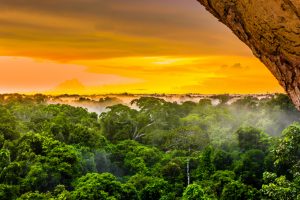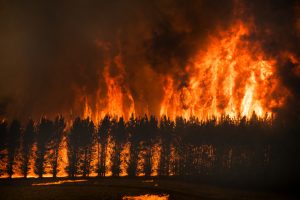Life is numerous. It is diverse with beautiful embellishments and intricate variations of color and form. Life on earth is complex. Yet, all the life forms on earth, despite their differences, interlock in such a graceful way that they sustain each other. They rely and thrive on each other. We, the humans, are just a single thread entangled in this complicated and fragile network of stability and sustenance. Thus, we are too entirely dependent on this elegant multitude of life on Earth.
On this day, May 22nd, we celebrate the “International Day for Biological Diversity” to commemorate the diverse life on earth. In 2021, we celebrate this day under the slogan, “We’re part of the solution, #ForNature”. This year is chosen as a continuation of the momentum generated last year under the theme, “Our Solutions are in Nature”. As people living in the 3rd decade of the 21st century, understanding that our global biodiversity is hauling towards disaster, is pivotal as never before.

What is Biodiversity?
Biodiversity, short for Biological Diversity, extend far from the variations of color, form, and structure of organisms. We can consider it in three levels,
- Genetic diversity
- Species diversity
- Ecosystem diversity
Genetic diversity comprises not only the individual genetic variation within populations but also the genetic variation between populations. Species diversity is the key factor for biodiversity awareness. We take the variations among the species across the biosphere and their numbers into consideration to measure the diversity among species. Ecosystem diversity is the combination of all the living and nonliving variations in the environment, making complex systems throughout the world.
All the exquisite variations of the living world are interconnected with each other. In this complicated system, one cannot thrive without the other. Earth itself is a finely tuned life-support machine. It relies on biodiversity across the globe to function smoothly.

Why Biodiversity Is Important?
“We are ultimately bound by and reliant upon the finite natural world about us”
-Sir David Attenborough
We all have heard about the importance of biodiversity. Still, have you understood why is it so important?
You cannot connect all the life on earth by yourself to understand it. Yet, if you can think about the functions of large ecosystems, you can get a fair idea of how the earth is hanging to its biodiversity.
To elaborate,
Phytoplankton and boreal forests of north fix trillions of Carbon each year preventing global warming. Schools of fish and herds of animals fertilize the earth, recycling the nutrients flowing through the earth system. Mangroves and Coral Reefs function as fish nurseries, ensuring the sustenance of fish populations. Rainforests in the tropics hold about half of all life on land. These green patches of land fix so much of the sun’s energy and provide moisture that generates air currents worldwide. Great desserts of Africa blow sand through the wind to fertilize the Amazon rainforest thousand miles away. Polar ice caps reflect the sun’s rays and cool the earth and they hold millions of liters of water preventing fluctuation of ocean levels.
Humans all around the earth rely on this intricate balance of nature for their day-to-day needs. Food, water, medicine, and all necessary things, somehow originate in nature. In 1997, scientists estimated the value of Earth’s ecosystem services at $33 trillion per year, nearly twice the gross national product of all the countries on Earth at the time ($18 trillion).
Be that as it may, no matter how much we understand the importance of the diversity of the world, we as the dominant species on earth are on a parade of destroying biodiversity.

When Biodiversity Has a Problem, Humanity Has a Problem.
The human population on earth has more than doubled as it was a century ago. With the increasing population, exploitation of the natural world has also increased at an alarming rate.
Even if we are not aware of it, fish provide 20% of animal protein for 3 billion people and over 80% of the human diet is based on plants. As many as 80% of people in developing countries rely on traditional plant-based medicines. Also, as we are well aware now, loss of biodiversity expands the chances of zoonotic diseases such as Covid-19.
For ten thousand years, the climate of the environment of the earth has only fluctuated by 10 C. However, according to NASA’s Goddard Institute, the global temperature has risen by 0.80 C since 1880. It is not just the temperature; arctic sea ice is declining 13.1% per decade. 90% of all large fish populations have disappeared. Agricultural activities have consumed 15.8% of global forest coverage. Reports by NASA indicate that 27% percent of all monitored coral reefs have disappeared.
Overall, the UN has reported an unprecedented rate of extinction of species – at the Paris convention, 2019 – between 1 000 to 10 000 times higher than the natural extinction.
If this rate of destruction doesn’t come to a halt, the self-sustaining systems of the earth will collapse within just a few decades. Scientists estimate, within the next hundred years, the Amazon rainforest will turn into a savannah, the Arctic will be free of ice in the summer, and methane trapped in the boreal forests will be released, leading to a global catastrophe.
Before we know it, we will be at another phase of global extinction.

Saving the Earth.
It might seem virtually impossible to stop the dawn of this catastrophe. But, it is simpler than you might think.
The key is sustainable development.
For centuries, each generation of humans has developed and modified the world around them at a pace greater than natural change. By definition that is unsustainable development. To restore the surrounding biodiversity, the first and foremost step is to develop and satisfy our requirements at a rate parallel to the rate of replenishing nature.
The second one is renewable energy. By reducing the burning of fossil fuels, we can reduce the CO2 added to the atmosphere to great extent and prevent global warming.
The third is reducing the population growth rate. As the human population grows, the space required for our sustenance increases alongside the resources required. If we can halt the population growth, we can minimize the exploitation of land and leave space for wildlife to thrive and biodiversity to replenish.

Works of CBD and UN.
The CBD – Convention on Biological Diversity, and The United Nations have represented two new decades for the period 2021–2030. “The UN Decade of Ocean Science for Sustainable Development” and the “UN Decade on Ecosystem Restoration”. They plan to make aware the world of nature-based solutions to climate change, health issues, food and security, and sustainable livelihoods, and the foundation of all of this is Biodiversity.
Biodiversity will have more events to celebrate this year in addition to the beginning of the new decade. The fifteenth meeting of the Conference of Parties (COP 14, 2021) will review the “Strategic Plan for Biodiversity” (2011 – 2020) by CBD. It is also anticipated that the final decision on the “post-2020 Global Biodiversity Framework” will be presented. According to the CBD, It will focus on “the nutrition, food security, and livelihoods of people, especially for the most vulnerable”.
Finally, on this day celebrating global biodiversity, we must realize that nature is our biggest ally and our greatest inspiration. We simply have to follow what nature has always done.
References:
Campbell N. A., Urry L. A., Cain M. L., Wasserman S. A., Minorsky P. V., Reece J. B., 2017. Campbell Biology. 11th ed. New York: Pearson Education.
CBD, 2021. 22 MAY 2021: INTERNATIONAL DAY FOR BIOLOGICAL DIVERSITY. [Online]
Available at: https://www.cbd.int/biodiversity-day
[Accessed 15 May 2021].
Nations, U., 2021. International Day For Biological Diversity 22 May. [Online]
Available at: https://www.un.org/en/observances/biological-diversity-day#:~:text=This%20year%202021%20the%20theme,to%20several%20sustainable%20development%20challenges.
[Accessed 15 May 2021].
Image courtesies:
Title Image – https://bit.ly/3opE5Dn
1st content Image – https://bit.ly/33KvdhY
2nd content Image – https://bit.ly/2RYm2rs
3rd content Image – https://bit.ly/3yhPLfE
4th content Image – https://bit.ly/3ot71KI
5th content Image – https://bit.ly/3ydOEOc

